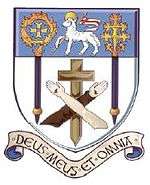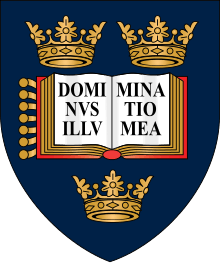Greyfriars, Oxford
| Colleges and halls of the University of Oxford | |||||||||||||||||||||||||||||||||
| Greyfriars | |||||||||||||||||||||||||||||||||
 | |||||||||||||||||||||||||||||||||
|
| |||||||||||||||||||||||||||||||||
| College name | Greyfriars | ||||||||||||||||||||||||||||||||
| Motto | My God and My All | ||||||||||||||||||||||||||||||||
| Named after | The Order of Friars Minor Capuchin | ||||||||||||||||||||||||||||||||
| Previously named | Grosseteste House (1919-1930) | ||||||||||||||||||||||||||||||||
| Established | 1224 | ||||||||||||||||||||||||||||||||
| Closed | 2008 | ||||||||||||||||||||||||||||||||
| The Warden | Mark Elvins | ||||||||||||||||||||||||||||||||
| Undergraduates | c. 50 (2008) | ||||||||||||||||||||||||||||||||
| Location | Iffley Road | ||||||||||||||||||||||||||||||||
| Franciscan Order-Oxford Homepage | |||||||||||||||||||||||||||||||||
 | |||||||||||||||||||||||||||||||||
Greyfriars, situated on the Iffley Road in East Oxford, was one of the smallest constituent Halls of the University of Oxford in England, that existed until 2008. Its previous status as a Permanent Private Hall (PPH) referred to the fact that it was governed by an outside institution (the Order of Friars Minor Capuchin, a Franciscan Order), rather than by its fellows as is a College.
Greyfriars has one of the most distinctive buildings in Oxford; it is the only flint-stone Norman-style building in the city, and its green spire is prominently visible along the Iffley Road and from the University's Roger Bannister running track.
History
The original Greyfriars church and friary was founded by the Franciscans in 1224, but was suppressed during the Reformation in the 16th century. The Friars had a long and esteemed history in Oxford, listing many famous alumni, including the English statesman, Robert Grosseteste, also a theologian and Bishop of Lincoln, who became head of Greyfriars, Master of the School of Oxford from 1208, and the first Chancellor of the University of Oxford.
Some time later, the Capuchin branch of the Order established a friary, known as St Anselm's, which was recognised by the University as a House of Studies in 1910. In 1919, the Friars moved to the current site on the Iffley Road — first naming it Grosseteste House after the first Head of the original Greyfriars — and on completion of the present building in 1930, the name of Greyfriars was adopted once more. The status of Permanent Private Hall was conferred upon Greyfriars by the University in 1957 and surrendered in 2008.
In 2007, Greyfriars celebrated 50 years of its PPH status, with considerable flourish, and an unusually high number of first-class undergraduate grades marked the year.
Controversy and closure
In March 2007, the Order announced without prior discussion to the Fellows or students its intention to withdraw from its ministry as a Permanent Private Hall of the University, for financial and personnel reasons and because the University appeared to be insisting on a more collegiate model for the Permanent Private Halls which, it was argued, would have made it untenable for the Friars, given their declining numbers of suitable personnel. The decision to close was unilaterally and without notice announced to Fellows, staff and students in October 2007. By private arrangement with the University, again without consultation, it was decided that all students and prospective applicants would transfer to Regent's Park College.[1] The decision aroused considerable controversy; substantial proposals by the Fellows for the continuation of Greyfriars Hall were considered by the Governing Body but never in an open forum. The University eventually indicated that the Friars' licence to run Greyfriars as a PPH would not be transferred to any other body, and the Hall closed in June 2008, despite the last-minute attempt to save the Hall by the Holy See.[2] The Capuchin Order states that it will continue to exist at Greyfriars in Oxford and the premises will continue to operate as a friary; the order will maintain responsibility for the parish.
Friary and tuition
Greyfriars occupied an uncommon position in Oxford, in that its University Hall and Franciscan friary were part of the same institution and coexisted on the same site — however, the friars were not usually members of the academic hall (though this was not without exception), nor were the students actually affiliated to the friary - the two groups did, however, mingle, most notably at mealtimes. (A similar system continues to operate with great success at Blackfriars, Oxford.) Furthermore, no religious restrictions were placed on applicants; and, while the Hall had a tradition of noted Theology academics, a wide range of disciplines were studied by students — the most common being English, History, Theology, Geography and Law. While the Hall employed tutors specialising in certain areas of some of these subjects, students generally went to other colleges for the majority of their tutorials. The College most closely linked with the Hall was Balliol College, due to a long-standing tradition of sporting links, but Greyfriars students were tutored at a wide number of the University's colleges at some point or another.
Student life
While Greyfriars was small in terms of grounds and numbers, it boasted a close-knit community and a lively academic life. Throughout the late 1990s and early 2000s, undergraduate numbers tended to be around the 30 mark, with an average of between nine and eleven students per year in addition to a handful of visiting and postgraduate students. From around 2003, numbers increased, and the student population of the Hall when it closed numbered closer to 50.
The Hall annually held a popular summer garden party, and a "bop" that was dubbed 'The Monastery of Sound' in tongue-in-cheek acknowledgement of the friars. Greyfriars was also influential in the Oxford Law Society, the Conservative Association, the Dramatic Society, and the Indie Music Society, as well as rowing, hockey, rugby, tennis and table tennis. Its increasing prominence was very much disproportionate to student numbers, which was testament to their eagerness to get involved in University life.
As with all Oxford colleges, Greyfriars' student community was a JCR, run by an annually elected committee usually consisting of a President, Secretary, Treasurer and various other Officers as necessary.
Famous former students (of the First Foundation)
- Antipope Alexander V (c.1339 – May 3, 1410)
- Hamo of Faversham (d. 1244)
- Alexander of Hales, Doctor Irrefragabilis (c.1170–1245)
- Adam Marsh, MA (d. 1258)
- Robert Grosseteste (c.1175–1253)
- Roger Bacon, DD, Doctor Mirabilis (c.1214–1292)
- John of Peckham, DD, (c.1225/30–1292)
- Thomas Docking (died 1270)
- John Duns Scotus, BD, DD, Doctor Subtilis (c.1264–1309)
- William of Occam, DD, Doctor Invincibilis (c.1300–1394)
Fellows and senior staff at the surrender of the licence
- The Visitor
- The Governing Body
- James Boner, Minister Provincial
- The Council of the Minister Provincial
- The Warden of Greyfriars (below)
- The Warden (Head of House)
- The Senior Tutor
- Richard Lawes
- The Fellows
- Jane Baun, Tutorial and Research Fellow in Theology, since 2003
- Jonathan Black-branch, Tutor in Law, since 2005
- Penelope Cookson, Tutor in Latin, since 2005
- Claire Hutton, Tutor in English, since 2004
- Richard Lawes, Fellow in English, since 2002
- Donal Lowry, Tutor in Modern History, since 2000
- Elizabeth Lowry, Tutor in English, since 2000
- Anne Mouron, Tutor in English, since 2000
- Aidan Nichols, John Paul II Lecturer in Roman Catholic Theology
- Alan O'Day, Tutor in Modern History, since 2001
- John Saward, Tutor in Theology, since 2003
- John Stevenson
- John Yocum, Tutor in Theology 2000-2003
- Honorary Fellows
- Thomas G. Weinandy, Since 2004
- Daniel Hill, since 2007
- Vincent Nichols, Archbishop of Birmingham, since 2007
- Maurice Sheehan, since 2007
- Director of Alumni & Development
- John E. J. James
Past Wardens
- Richard Roderham, medieval churchman (1433-1440)
- Peter Peacock
- Cassian Reel
- Maurice Sheehan
- Thomas More
- Thomas G. Weinandy (1991-2004)
- Nicholas Richardson (2004-2007)
- Mark Elvins, the final Warden of Greyfriars (2007-2008)
Greyfriars Society
The Greyfriars Society was established in 1999 and is the official alumni organisation of Greyfriars. The main objectives of the society are to maintain and build relationships with the Hall's alumni and were also to raise money to enable Greyfriars to provide the best possible education for the growing student body.
- Patron
- President
- The Director
- John E. J. James
- Deputy Directors
- Rupert Abbott
- James Campbell
References
- ↑ "Capuchin Friars to leave Greyfriars Hall". Archived from the original on September 27, 2008.
- ↑ Article, Catholic Herald. Archived October 16, 2009, at the Wayback Machine.
External links
Coordinates: 51°44′48″N 1°14′25″W / 51.746801°N 1.240168°W
